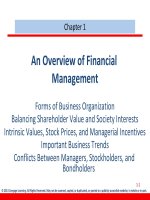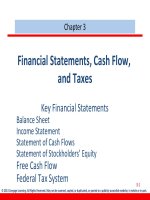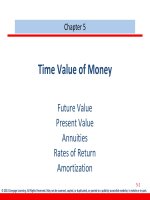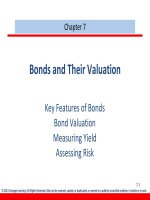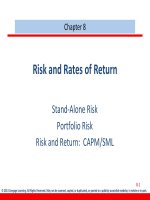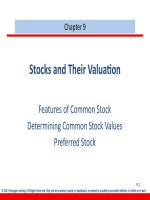Finance management cengage 2013 chapter 04
Bạn đang xem bản rút gọn của tài liệu. Xem và tải ngay bản đầy đủ của tài liệu tại đây (1.09 MB, 35 trang )
Chapter 4
Analysis of Financial Statements
Ratio Analysis
DuPont Equation
Effects of Improving Ratios
Limitations of Ratio Analysis
Qualitative Factors
4-1
© 2013 Cengage Learning. All Rights Reserved. May not be scanned, copied, or duplicated, or posted to a publicly accessible website, in whole or in part.
Balance Sheet: Assets
Cash
A/R
Inventories
Total CA
Gross FA
Less: Deprec.
Net FA
Total Assets
2013E
85,632
878,000
1,716,480
2,680,112
1,197,160
380,120
817,040
3,497,152
2012
7,282
632,160
1,287,360
1,926,802
1,202,950
263,160
939,790
2,866,592
4-2
© 2013 Cengage Learning. All Rights Reserved. May not be scanned, copied, or duplicated, or posted to a publicly accessible website, in whole or in part.
Balance Sheet: Liabilities and Equity
Accts payable
Notes payable
Accruals
Total CL
Long-term debt
Common stock
Retained earnings
Total Equity
Total L & E
2013E
436,800
300,000
408,000
1,144,800
400,000
1,721,176
231,176
1,952,352
3,497,152
2012
524,160
636,808
489,600
1,650,568
723,432
460,000
32,592
492,592
2,866,592
4-3
© 2013 Cengage Learning. All Rights Reserved. May not be scanned, copied, or duplicated, or posted to a publicly accessible website, in whole or in part.
Income Statement
Sales
COGS
Other expenses
EBITDA
Deprec. & amort.
EBIT
Interest exp.
EBT
Taxes
Net income
2013E
7,035,600
5,875,992
550,000
609,608
116,960
492,648
70,008
422,640
169,056
253,584
2012
6,034,000
5,528,000
519,988
(13,988)
116,960
(130,948)
136,012
(266,960)
(106,784) 4-4
© 2013 Cengage Learning. All Rights Reserved. May not be scanned, copied, or duplicated, or posted to a publicly accessible website, in whole or in part.
(160,176)
Other Data
No. of shares
EPS
DPS
Stock price
Lease pmts
2013E
250,000
$1.014
$0.220
$12.17
$40,000
2012
100,000
-$1.602
$0.110
$2.25
$40,000
4-5
© 2013 Cengage Learning. All Rights Reserved. May not be scanned, copied, or duplicated, or posted to a publicly accessible website, in whole or in part.
Why are ratios useful?
•
Ratios standardize numbers and facilitate
comparisons.
•
Ratios are used to highlight weaknesses and
strengths.
•
Ratio comparisons should be made through time
and with competitors.
– Trend analysis
– Industry analysis
– Benchmark (peer) analysis
4-6
© 2013 Cengage Learning. All Rights Reserved. May not be scanned, copied, or duplicated, or posted to a publicly accessible website, in whole or in part.
Five Major Categories of Ratios and the
Questions They Answer
•
•
Liquidity: Can we make required payments?
•
•
Debt management: Right mix of debt and equity?
•
Market value: Do investors like what they see as
reflected in P/E and M/B ratios?
Asset management: Right amount of assets vs.
sales?
Profitability: Do sales prices exceed unit costs, and
are sales high enough as reflected in PM, ROE, and
ROA?
4-7
© 2013 Cengage Learning. All Rights Reserved. May not be scanned, copied, or duplicated, or posted to a publicly accessible website, in whole or in part.
D’Leon’s Forecasted Current Ratio and Quick
Ratio for 2013
Current assets
Current ratio =
Current liabilitie s
$2,680
=
$1,145
= 2.34 ×
(Current assets − Inventorie s)
Current liabilitie s
($2,680 − $1,716)
=
$1,145
= 0.84 ×
Quick ratio =
4-8
© 2013 Cengage Learning. All Rights Reserved. May not be scanned, copied, or duplicated, or posted to a publicly accessible website, in whole or in part.
Comments on Liquidity Ratios
2013E
2012
2011
Ind.
Current ratio
2.34x
1.20x
2.30x
2.70x
Quick ratio
0.84x
0.39x
0.85x
1.00x
•
Expected to improve but still below the industry
average.
•
Liquidity position is weak.
4-9
© 2013 Cengage Learning. All Rights Reserved. May not be scanned, copied, or duplicated, or posted to a publicly accessible website, in whole or in part.
D’Leon’s Inventory Turnover vs. the Industry
Average
Inv. turnover = Sales/Inventories
= $7,036/$1,716
= 4.10x
Inventory turnover
2013E
2012
2011
Ind.
4.1x
4.70x
4.8x
6.1x
4-10
© 2013 Cengage Learning. All Rights Reserved. May not be scanned, copied, or duplicated, or posted to a publicly accessible website, in whole or in part.
Comments on Inventory Turnover
•
•
Inventory turnover is below industry average.
•
No improvement is currently forecasted.
D’Leon might have old inventory, or its control
might be poor.
4-11
© 2013 Cengage Learning. All Rights Reserved. May not be scanned, copied, or duplicated, or posted to a publicly accessible website, in whole or in part.
DSO: Average Number of Days after Making a
Sale before Receiving Cash
DSO = Receivables/Avg. sales per day
= Receivables/(Annual sales/365)
= $878/($7,036/365)
= 45.6 days
4-12
© 2013 Cengage Learning. All Rights Reserved. May not be scanned, copied, or duplicated, or posted to a publicly accessible website, in whole or in part.
Appraisal of DSO
DSO
2013E
2012
2011
Ind.
45.6
38.2
37.4
32.0
•
D’Leon collects on sales too slowly, and is getting
worse.
•
D’Leon has a poor credit policy.
4-13
© 2013 Cengage Learning. All Rights Reserved. May not be scanned, copied, or duplicated, or posted to a publicly accessible website, in whole or in part.
Fixed Assets and Total Assets Turnover Ratios vs.
the Industry Average
FA turnover = Sales/Net fixed assets
= $7,036/$817 = 8.61x
TA turnover = Sales/Total assets
= $7,036/$3,497 = 2.01x
4-14
© 2013 Cengage Learning. All Rights Reserved. May not be scanned, copied, or duplicated, or posted to a publicly accessible website, in whole or in part.
Evaluating the FA Turnover (S/Net FA) and TA
Turnover (S/TA) Ratios
2013E
2012
2011
Ind.
FA TO
8.6x
6.4x
10.0x
7.0x
TA TO
2.0x
2.1x
2.3x
2.6x
•
FA turnover projected to exceed the industry
average.
•
TA turnover below the industry average. Caused by
excessive currents assets (A/R and Inv).
4-15
© 2013 Cengage Learning. All Rights Reserved. May not be scanned, copied, or duplicated, or posted to a publicly accessible website, in whole or in part.
Calculate the Debt Ratio and
Times-Interest-Earned Ratio
Debt ratio = Total debt/Total assets
= ($1,145 + $400)/$3,497
= 44.2%
TIE = EBIT/Interest charges
= $492.6/$70 = 7.0x
4-16
© 2013 Cengage Learning. All Rights Reserved. May not be scanned, copied, or duplicated, or posted to a publicly accessible website, in whole or in part.
D’Leon’s Debt Management Ratios vs. the
Industry Averages
•
2013E
2012
2011
Ind.
D/A
44.2%
82.8%
54.8%
50.0%
TIE
7.0x
-1.0x
4.3x
6.2x
D/A and TIE are better than the industry average.
4-17
© 2013 Cengage Learning. All Rights Reserved. May not be scanned, copied, or duplicated, or posted to a publicly accessible website, in whole or in part.
Profitability Ratios: Operating Margin, Profit Margin,
and Basic Earning Power
4-18
© 2013 Cengage Learning. All Rights Reserved. May not be scanned, copied, or duplicated, or posted to a publicly accessible website, in whole or in part.
Appraising Profitability with Operating Margin, Profit
Margin, and Basic Earning Power
Operating margin
Profit margin
Basic earning power
2013E
2012
2011
Ind.
7.0%
3.6%
14.1%
-2.2%
-2.7%
-4.6%
5.6% 7.3%
2.6% 3.5%
13.0% 19.1%
4-19
© 2013 Cengage Learning. All Rights Reserved. May not be scanned, copied, or duplicated, or posted to a publicly accessible website, in whole or in part.
Appraising Profitability with Operating Margin, Profit
Margin, and Basic Earning Power
•
Operating margin was very bad in 2012. It is
projected to improve in 2013, but it is still projected
to remain below the industry average.
•
Profit margin was very bad in 2012 but is projected
to exceed the industry average in 2013. Looking
good.
•
BEP removes the effects of taxes and financial
leverage, and is useful for comparison.
•
BEP projected to improve, yet still below the
industry average. There is definitely room for
improvement.
4-20
© 2013 Cengage Learning. All Rights Reserved. May not be scanned, copied, or duplicated, or posted to a publicly accessible website, in whole or in part.
Profitability Ratios: Return on Assets and Return
on Equity
ROA = Net income/Total assets
= $253.6/$3,497 = 7.3%
ROE = Net income/Total common equity
= $253.6/$1,952 = 13.0%
4-21
© 2013 Cengage Learning. All Rights Reserved. May not be scanned, copied, or duplicated, or posted to a publicly accessible website, in whole or in part.
Appraising Profitability with ROA
and ROE
ROA
ROE
2013E
2012
2011
Ind.
7.3%
13.0%
-5.6%
-32.5%
6.0%
13.3%
9.1%
18.2%
•
Both ratios rebounded from the previous year, but
are still below the industry average. More
improvement is needed.
•
Wide variations in ROE illustrate the effect that
leverage can have on profitability.
4-22
© 2013 Cengage Learning. All Rights Reserved. May not be scanned, copied, or duplicated, or posted to a publicly accessible website, in whole or in part.
Effects of Debt on ROA and ROE
•
Holding assets constant, if debt increases:
– Equity declines.
– Interest expense increases – which leads to a
reduction in net income.
•
•
ROA declines (due to the reduction in net income).
ROE may increase or decrease (since both net
income and equity decline).
4-23
© 2013 Cengage Learning. All Rights Reserved. May not be scanned, copied, or duplicated, or posted to a publicly accessible website, in whole or in part.
Problems with ROE
•
ROE and shareholder wealth are correlated, but
problems can arise when ROE is the sole measure
of performance.
– ROE does not consider risk.
– ROE does not consider the amount of capital
•
invested.
Given these problems, reliance on ROE may
encourage managers to make investments that do
not benefit shareholders. As a result, analysts have
looked to develop other performance measures,
such as EVA.
4-24
© 2013 Cengage Learning. All Rights Reserved. May not be scanned, copied, or duplicated, or posted to a publicly accessible website, in whole or in part.
Calculate the Price/Earnings and Market/Book
Ratios
P/E = Price/Earnings per share
= $12.17/$1.014 = 12.0x
M/B = Market price/Book value per share
= $12.17/($1,952/250) = 1.56x
2013E
2012
2011
Ind.
P/E
12.0x
-1.4x
9.7x
14.2x
M/B
1.56x
0.5x
1.3x
2.4x
4-25
© 2013 Cengage Learning. All Rights Reserved. May not be scanned, copied, or duplicated, or posted to a publicly accessible website, in whole or in part.

